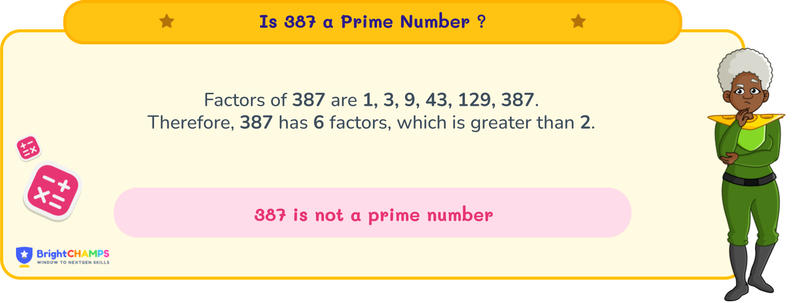Summarize this article:
 186 Learners
186 LearnersLast updated on August 5, 2025
Is 387 a Prime Number?

Prime numbers have only two factors: 1 and itself. They play a crucial role in various fields like encryption, computer algorithms, and barcode generation. In this topic, we will be discussing whether 387 is a prime number or not.

Is 387 a Prime Number?
Numbers can be classified as either prime or composite based on their factors. A prime number is a natural number greater than 1 that is divisible only by 1 and itself.
For example, 3 is a prime number because it has only two divisors: 1 and 3.
A composite number has more than two divisors.
For instance, 6 is composite because it has divisors 1, 2, 3, and 6.
Key properties of prime numbers include:
Prime numbers are greater than 1.
2 is the only even prime number.
They have exactly two factors: 1 and the number itself.
Two distinct prime numbers are co-prime as their only common factor is 1.
Since 387 has more than two factors, it is not a prime number.


Why is 387 Not a Prime Number?
A prime number has exactly two divisors: 1 and itself. Since 387 has more than two factors, it is not a prime number. Several methods can be employed to distinguish between prime and composite numbers:
- Counting Divisors Method
- Divisibility Test
- Prime Number Chart
- Prime Factorization

Using the Counting Divisors Method
The counting divisors method involves counting the number of divisors a number has to determine if it is prime or composite.
If a number has exactly 2 divisors, it is prime.
If it has more than 2 divisors, it is composite.
Let's verify whether 387 is prime or composite:
Step 1: Every number is divisible by 1 and itself.
Step 2: Check divisibility of 387 by 2. Since 387 is odd, it is not divisible by 2.
Step 3: Divide 387 by 3. The sum of the digits (3 + 8 + 7) is 18, which is divisible by 3, so 3 is a factor.
Step 4: Check divisibility by other numbers up to the square root of 387. Since 387 has more than 2 divisors, it is a composite number.
Explore Our Programs



Using the Divisibility Test Method
We use divisibility rules to determine if a number is divisible by another number without a remainder: - Divisibility by 2: 387 is odd, so it is not divisible by 2.
Divisibility by 3: The digit sum of 387 is 18, which is divisible by 3, so 387 is divisible by 3.
Divisibility by 5: The last digit of 387 is not 0 or 5, so it is not divisible by 5.
Divisibility by 7: Double the last digit (7 × 2 = 14), then subtract from the rest (38 - 14 = 24). Since 24 is divisible by 7, 387 is divisible by 7.
Divisibility by 11: The alternating sum of digits (3 - 8 + 7 = 2) is not divisible by 11. Since 387 has more than two factors.
it is a composite number.

Using Prime Number Chart
The prime number chart is a tool created using the Sieve of Eratosthenes:
1. List numbers from 1 to 100 in rows and columns.
2. Leave 1 unmarked as it is neither prime nor composite.
3. Mark 2 and cross out multiples of 2.
4. Mark 3 and cross out multiples of 3.
5. Continue until all primes are marked. From this process, we find that 387 is not in the list of prime numbers, confirming it is a composite number.

Using the Prime Factorization Method
Prime factorization involves expressing a number as a product of prime factors:
1. Start with 387.
2. Divide by the smallest prime, 3: 387 ÷ 3 = 129.
3. Divide 129 by 3 again: 129 ÷ 3 = 43.
4. 43 is a prime number.
Thus, the prime factorization of 387 is 3 × 3 × 43.

Common Mistakes to Avoid When Determining if 387 is Not a Prime Number
Learners might make errors when exploring prime numbers. Here are some typical mistakes:

FAQ on Is 387 a Prime Number?
1.Is 387 a perfect square?
2.What is the sum of the divisors of 387?
3.What are the factors of 387?
4.What are the closest prime numbers to 387?
5.What is the prime factorization of 387?

Important Glossaries for "Is 387 a Prime Number"
- Composite numbers: Natural numbers greater than 1 that have more than two divisors. Example: 12, with divisors 1, 2, 3, 4, 6, and 12.
- Prime numbers: Natural numbers greater than 1 with exactly two distinct divisors: 1 and itself. Example: 7.
- Divisibility: A number is divisible by another if the remainder is zero when divided.
- Factors: Numbers that divide another number completely. Example: Factors of 4 are 1, 2, and 4.
- Prime factorization: Expressing a number as a product of its prime factors. Example: 20 is 2 × 2 × 5.



Hiralee Lalitkumar Makwana
About the Author
Hiralee Lalitkumar Makwana has almost two years of teaching experience. She is a number ninja as she loves numbers. Her interest in numbers can be seen in the way she cracks math puzzles and hidden patterns.
Fun Fact
: She loves to read number jokes and games.

















